Telecoupling Research: The First Five Years
Abstract
1. Introduction
2. Review Criteria
3. Overview of Five Years of Telecoupling Research
4. Emergent Themes from the Telecoupling Literature
5. Future Directions for Telecoupling Research
6. Conclusion
Supplementary Materials
Author Contributions
Funding
Acknowledgments
Conflicts of Interest
References
- Crona, B.I.; Van Holt, T.; Petersson, M.; Daw, T.M.; Buchary, E. Using social–ecological syndromes to understand impacts of international seafood trade on small-scale fisheries. Glob. Environ. Chang. 2015, 35, 162–175. [Google Scholar] [CrossRef]
- Parish, E.S.; Herzberger, A.J.; Phifer, C.C.; Dale, V.H. Transatlantic wood pellet trade demonstrates telecoupled benefits. Ecol. Soc. 2018, 23, 28. [Google Scholar] [CrossRef]
- Silva, R.; Batistella, M.; Dou, Y.; Moran, E.; Torres, S.; Liu, J. The Sino-Brazilian Telecoupled Soybean System and Cascading Effects for the Exporting Country. Land 2017, 6, 53. [Google Scholar] [CrossRef]
- Dalin, C.; Wada, Y.; Kastner, T.; Puma, M.J. Groundwater depletion embedded in international food trade. Nature 2017, 543, 700–704. [Google Scholar] [CrossRef] [PubMed]
- Torres, A.; Brandt, J.; Lear, K.; Liu, J. A looming tragedy of the sand commons. Science 2017, 357, 970–971. [Google Scholar] [CrossRef] [PubMed]
- Liu, J.; Dietz, T.; Carpenter, S.R.; Folke, C.; Alberti, M.; Redman, C.L.; Schneider, S.H.; Ostrom, E.; Pell, A.N.; Lubchenco, J.; et al. Coupled human and natural systems. Ambio 2007, 36, 639–649. [Google Scholar] [CrossRef]
- Banse, M.; van Meijl, H.; Tabeau, A.; Woltjer, G. Will EU biofuel policies affect global agricultural markets? Eur. Rev. Agric. Econ. 2008, 35, 117–141. [Google Scholar] [CrossRef]
- Meyfroidt, P.; Rudel, T.K.; Lambin, E.F. Forest transitions, trade, and the global displacement of land use. Proc. Natl. Acad. Sci. USA 2010, 107, 20917–20922. [Google Scholar] [CrossRef]
- Liu, J.; Hull, V.; Batistella, M.; DeFries, R.; Dietz, T.; Fu, F.; Hertel, T.W.; Izaurralde, R.C.; Lambin, E.F.; Li, S.; et al. Framing Sustainability in a Telecoupled World. Ecol. Soc. 2013, 18, 26. [Google Scholar] [CrossRef]
- Glantz, M.H.; Katz, R.W.; Nicholls, N. Teleconnections Linking Worldwide Climate Anomalies; Cambridge University Press: Cambridge, UK, 2009; ISBN 9780521106849. [Google Scholar]
- Haberl, H.; Erb, K.-H.; Krausmann, F.; Berecz, S.; Ludwiczek, N.; Martínez-Alier, J.; Musel, A.; Schaffartzik, A. Using embodied HANPP to analyze teleconnections in the global land system: Conceptual considerations. Geografisk Tidsskrift-Dan. J. Geogr. 2009, 109, 119–130. [Google Scholar] [CrossRef]
- Reenberg, A.; Fenger, N.A. Globalizing land use transitions: The soybean acceleration. Geografisk Tidsskrift-Dan. J. Geogr. 2011, 111, 85–92. [Google Scholar] [CrossRef]
- Seto, K.C.; Reenberg, A.; Boone, C.G.; Fragkias, M.; Haase, D.; Langanke, T.; Marcotullio, P.; Munroe, D.K.; Olah, B.; Simon, D. Urban land teleconnections and sustainability. Proc. Natl. Acad. Sci. USA 2012, 109, 7687–7692. [Google Scholar] [CrossRef] [PubMed]
- Lenschow, A.; Newig, J.; Challies, E. Globalization’s limits to the environmental state? Integrating telecoupling into global environmental governance. Environ. Politics 2015, 25, 136–159. [Google Scholar] [CrossRef]
- Carlson, A.K.; Taylor, W.W.; Liu, J.; Orlic, I. Peruvian anchoveta as a telecoupled fisheries system. Ecol. Soc. 2018, 23. [Google Scholar] [CrossRef]
- Liu, J.; Yang, W. Integrated assessments of payments for ecosystem services programs. Proc. Natl. Acad. Sci. USA 2013, 110, 16297–16298. [Google Scholar] [CrossRef] [PubMed]
- López-Hoffman, L.; Diffendorfer, J.; Wiederholt, R.; Bagstad, K.J.; Thogmartin, W.E.; McCracken, G.; Medellin, R.L.; Russell, A.; Semmens, D.J. Operationalizing the telecoupling framework for migratory species using the spatial subsidies approach to examine ecosystem services provided by Mexican free-tailed bats. Ecol. Soc. 2017, 22, 23. [Google Scholar] [CrossRef]
- Hulina, J.; Bocetti, C.; Iii, H.C.; Hull, V.; Yang, W.; Liu, J. Telecoupling framework for research on migratory species in the Anthropocene. Elem. Sci. Anth. 2017, 5, 5. [Google Scholar] [CrossRef]
- Munroe, D.K.; McSweeney, K.; Olson, J.L.; Mansfield, B. Using economic geography to reinvigorate land-change science. Geoforum 2014, 52, 12–21. [Google Scholar] [CrossRef]
- Liu, J.; Yang, W.; Li, S. Framing ecosystem services in the telecoupled Anthropocene. Front. Ecol. Environ. 2016, 14, 27–36. [Google Scholar] [CrossRef]
- Carrasco, L.R.; Roman Carrasco, L.; Chan, J.; McGrath, F.L.; Nghiem, L.T.P. Biodiversity conservation in a telecoupled world. Ecol. Soc. 2017, 22, 24. [Google Scholar] [CrossRef]
- Eakin, H.; Rueda, X.; Mahanti, A. Transforming governance in telecoupled food systems. Ecol. Soc. 2017, 22, 32. [Google Scholar] [CrossRef]
- Fang, B.; Tan, Y.; Li, C.; Cao, Y.; Liu, J.; Schweizer, P.-J.; Shi, H.; Zhou, B.; Chen, H.; Hu, Z. Energy sustainability under the framework of telecoupling. Energy 2016, 106, 253–259. [Google Scholar] [CrossRef]
- Liu, J.; Mooney, H.; Hull, V.; Davis, S.J.; Gaskell, J.; Hertel, T.; Lubchenco, J.; Seto, K.C.; Gleick, P.; Kremen, C.; et al. Sustainability. Systems integration for global sustainability. Science 2015, 347, 1258832. [Google Scholar] [CrossRef] [PubMed]
- Wang, F.; Liu, J. Conservation planning beyond giant pandas: The need for an innovative telecoupling framework. Sci. China Life Sci. 2017, 60, 551–554. [Google Scholar] [CrossRef] [PubMed]
- Moher, D.; Liberati, A.; Tetzlaff, J.; Altman, D.G. The PRISMA Group Preferred Reporting Items for Systematic Reviews and Meta-Analyses: The PRISMA Statement. PLoS Med. 2009, 6, e1000097. [Google Scholar] [CrossRef] [PubMed]
- Liu, J. Forest Sustainability in China and Implications for a Telecoupled World. Asia Pac. Policy Stud. 2013, 1, 230–250. [Google Scholar] [CrossRef]
- Sun, J.; Tong, Y.-X.; Liu, J. Telecoupled land-use changes in distant countries. J. Integr. Agric. 2017, 16, 368–376. [Google Scholar] [CrossRef]
- Liu, J.; Hull, V.; Luo, J.; Yang, W.; Liu, W.; Viña, A.; Vogt, C.; Xu, Z.; Yang, H.; Zhang, J.; et al. Multiple telecouplings and their complex interrelationships. Ecol. Soc. 2015, 20, 44. [Google Scholar] [CrossRef]
- Deines, J.M.; Liu, X.; Liu, J. Telecoupling in urban water systems: An examination of Beijing’s imported water supply. Water Int. 2015, 41, 251–270. [Google Scholar] [CrossRef]
- Yang, W.; Hyndman, D.W.; Winkler, J.A.; Viña, A.; Deines, J.M.; Lupi, F.; Luo, L.; Li, Y.; Basso, B.; Zheng, C.; et al. Urban water sustainability: Framework and application. Ecol. Soc. 2016, 21, 4. [Google Scholar] [CrossRef]
- Liu, J.; Hull, V.; Moran, E.; Nagendra, H.; Swaffield, S.R.; Turner, B.L., II. Applications of the Telecoupling Framework to Land-Change Science. In Rethinking Global Land Use in an Urban Era; MIT Press: Cambridge, MA, USA, 2014; pp. 119–140. [Google Scholar]
- Fang, C.; Ren, Y. Analysis of emergy-based metabolic efficiency and environmental pressure on the local coupling and telecoupling between urbanization and the eco-environment in the Beijing-Tianjin-Hebei urban agglomeration. Sci. China Earth Sci. 2017, 60, 1083–1097. [Google Scholar] [CrossRef]
- Sun, J.; Mooney, H.; Wu, W.; Tang, H.; Tong, Y.; Xu, Z.; Huang, B.; Cheng, Y.; Yang, X.; Wei, D.; et al. Importing food damages domestic environment: Evidence from global soybean trade. Proc. Natl. Acad. Sci. USA 2018, 115, 5415–5419. [Google Scholar] [CrossRef] [PubMed]
- Gasparri, N.I.; de Waroux, Y.L.P. The Coupling of South American Soybean and Cattle Production Frontiers: New Challenges for Conservation Policy and Land Change Science. Conserv. Lett. 2015, 8, 290–298. [Google Scholar] [CrossRef]
- Cease, A.J.; Elser, J.J.; Fenichel, E.P.; Hadrich, J.C.; Harrison, J.F.; Robinson, B.E. Living with locusts: Connecting soil nitrogen, locust outbreaks, livelihoods, and livestock markets. Bioscience 2015, 65, 551–558. [Google Scholar] [CrossRef]
- Chignell, S.M.; Laituri, M.J. Telecoupling, urbanization, and the unintended consequences of water development aid in Ethiopia. In Geoscience for the Public Good and Global Development: Toward a Sustainable Future; Geological Society of America Special Papers; Geological Society of America: Boulder, CO, USA, 2016; Volume 520, pp. 125–135. ISBN 9780813725208. [Google Scholar]
- Dou, Y.; Liu, J. Modeling telecoupled systems: Design for simulating telecoupled soybean trade. In Proceedings of the 20th Annual Conference on Global Economic Analysis, West Lafayette, IN, USA, 7–9 June 2017. [Google Scholar]
- Tonini, F.; Liu, J. Telecoupling Toolbox: Spatially explicit tools for studying telecoupled human and natural systems. Ecol. Soc. 2017, 22, 11. [Google Scholar] [CrossRef]
- McCord, P.; Tonini, F.; Liu, J. The Telecoupling GeoApp: A Web-GIS application to systematically analyze telecouplings and sustainable development. Appl. Geogr. 2018, 96, 16–28. [Google Scholar] [CrossRef]
- Liu, J.; Dou, Y.; Batistella, M.; Challies, E.; Connor, T.; Friis, C.; DA Millington, J.; Parish, E.; Romulo, C.L.; Silva, R.F.B.; et al. Spillover systems in a telecoupled Anthropocene: Typology, methods, and governance for global sustainability. Curr. Opin. Environ. Sustain. 2018, 33, 58–69. [Google Scholar] [CrossRef]
- DeSombre, E.R. Globalization, Competition, and Convergence: Shipping and the Race to the Middle. Glob. Gov. 2008, 14, 179–198. [Google Scholar] [CrossRef]
- Vanderlaan, A.S.M.; Taggart, C.T. Efficacy of a voluntary area to be avoided to reduce risk of lethal vessel strikes to endangered whales. Conserv. Biol. 2009, 23, 1467–1474. [Google Scholar] [CrossRef]
- Alves, T.M.; Kokinou, E.; Zodiatis, G.; Radhakrishnan, H.; Panagiotakis, C.; Lardner, R. Multidisciplinary oil spill modeling to protect coastal communities and the environment of the Eastern Mediterranean Sea. Sci. Rep. 2016, 6, 36882. [Google Scholar] [CrossRef]
- Barki, D.; Deleze-Black, L. (Eds.) Review of Maritime Transport 2017 (UNCTAD/RMT/2017); United Nations Conference on Trade and Development (UNCTAD): Geneva, Switerland.
- Torres, S.; Moran, E.; Silva, R. Property Rights and the Soybean Revolution: Shaping How China and Brazil Are Telecoupled. Sustainability 2017, 9, 954. [Google Scholar] [CrossRef]
- Gasparri, N.I.; Kuemmerle, T.; Meyfroidt, P.; le Polain de Waroux, Y.; Kreft, H. The Emerging Soybean Production Frontier in Southern Africa: Conservation Challenges and the Role of South-South Telecouplings. Conserv. Lett. 2016, 9, 21–31. [Google Scholar] [CrossRef]
- Vanwey, L.K.; Richards, P.D.; Lathuillière, M.J.; Johnson, M.S.; Galford, G.L.; Garrett, R.D.; Carlson, K.M.; Rueda, X.; Henders, S.; Persson, M.; et al. Globalization’s unexpected impact on soybean production in South America: Linkages between preferences for non-genetically modified crops, eco-certifications, and land use. Environ. Res. Lett. 2013, 8, 44055. [Google Scholar]
- Millington, J.; Xiong, H.; Peterson, S.; Woods, J. Integrating Modelling Approaches for Understanding Telecoupling: Global Food Trade and Local Land Use. Land 2017, 6, 56. [Google Scholar] [CrossRef]
- Yao, G.; Hertel, T.W.; Taheripour, F. Economic drivers of telecoupling and terrestrial carbon fluxes in the global soybean complex. Glob. Environ. Chang. 2018, 50, 190–200. [Google Scholar] [CrossRef]
- Ostrom, E. Governing the Commons; Cambridge university press: Cambridge, UK, 1990. [Google Scholar]
- Oberlack, C.; Tejada, L.; Messerli, P.; Rist, S.; Giger, M. Sustainable livelihoods in the global land rush? Archetypes of livelihood vulnerability and sustainability potentials. Glob. Environ. Chang. 2016, 41, 153–171. [Google Scholar] [CrossRef]
- Sietz, D.; Ordoñez, J.C.; Kok, M.T.J.; Janssen, P.; Hilderink, H.B.M.; Tittonell, P.; Van Dijk, H. Nested archetypes of vulnerability in African drylands: Where lies potential for sustainable agricultural intensification? Environ. Res. Lett. 2017, 12, 095006. [Google Scholar] [CrossRef]
- Meyfroidt, P. Approaches and terminology for causal analysis in land systems science. J. Land Use Sci. 2016, 11, 501–522. [Google Scholar] [CrossRef]
- Carlson, A.; Zaehringer, J.; Garrett, R.; Felipe Bicudo Silva, R.; Furumo, P.; Raya Rey, A.; Torres, A.; Gon Chung, M.; Li, Y.; Liu, J. Toward Rigorous Telecoupling Causal Attribution: A Systematic Review and Typology. Sustainability 2018, 10, 4426. [Google Scholar] [CrossRef]
- Eakin, H.; DeFries, R.; Kerr, S.; Lambin, E.F.; Liu, J.; Marcotullio, P.J.; Messerli, P.; Reenberg, A.; Rueda, X.; Swaffield, S.R.; et al. Significance of Telecoupling for Exploration of Land-Use Change. In Rethinking Global Land Use in an Urban Era; MIT Press: Cambridge, MA, USA, 2014; pp. 141–161. [Google Scholar]
- Kissinger, M.; Rees, W.E.; Timmer, V. Interregional sustainability: Governance and policy in an ecologically interdependent world. Environ. Sci. Policy 2011, 14, 965–976. [Google Scholar] [CrossRef]
- Oberlack, C.; Boillat, S.; Brönnimann, S.; Gerber, J.-D.; Heinimann, A.; Ifejika Speranza, C.; Messerli, P.; Rist, S.; Wiesmann, U. Polycentric governance in telecoupled resource systems. Ecol. Soc. 2018, 23, 16. [Google Scholar] [CrossRef]
- Ostrom, E. Polycentric systems for coping with collective action and global environmental change. Glob. Environ. Chang. 2010, 20, 550–557. [Google Scholar] [CrossRef]
- Schaffer-Smith, D.; Tomscha, S.A.; Jarvis, K.J.; Maguire, D.Y.; Treglia, M.L.; Liu, J. Network analysis as a tool for quantifying the dynamics of metacoupled systems: An example using global soybean trade. Ecol. Soc. 2018, 23, 3. [Google Scholar] [CrossRef]
- Rueda, X.; Lambin, E.F. Linking Globalization to Local Land Uses: How Eco-Consumers and Gourmands are Changing the Colombian Coffee Landscapes. World Dev. 2013, 41, 286–301. [Google Scholar] [CrossRef]
- Lambin, E.F.; Gibbs, H.K.; Heilmayr, R.; Carlson, K.M.; Fleck, L.C.; Garrett, R.D.; de Waroux, Y.l.P.; McDermott, C.L.; McLaughlin, D.; Newton, P.; et al. The role of supply-chain initiatives in reducing deforestation. Nat. Clim. Chang. 2018, 8, 109–116. [Google Scholar] [CrossRef]
- Liu, J. Integration across a metacoupled world. Ecol. Soc. 2017, 22, 29. [Google Scholar] [CrossRef]
- Griggs, D.; Smith, M.S.; Rockström, J.; Öhman, M.C.; Gaffney, O.; Glaser, G.; Kanie, N.; Noble, I.; Steffen, W.; Shyamsundar, P. An integrated framework for sustainable development goals. Ecol. Soc. 2014, 19, 49. [Google Scholar] [CrossRef]
- Liu, J.; Viña, A.; Yang, W.; Li, S.; Xu, W.; Zheng, H. China’s Environment on a Metacoupled Planet. Annu. Rev. Environ. Resour. 2018, 43, 1–34. [Google Scholar] [CrossRef]
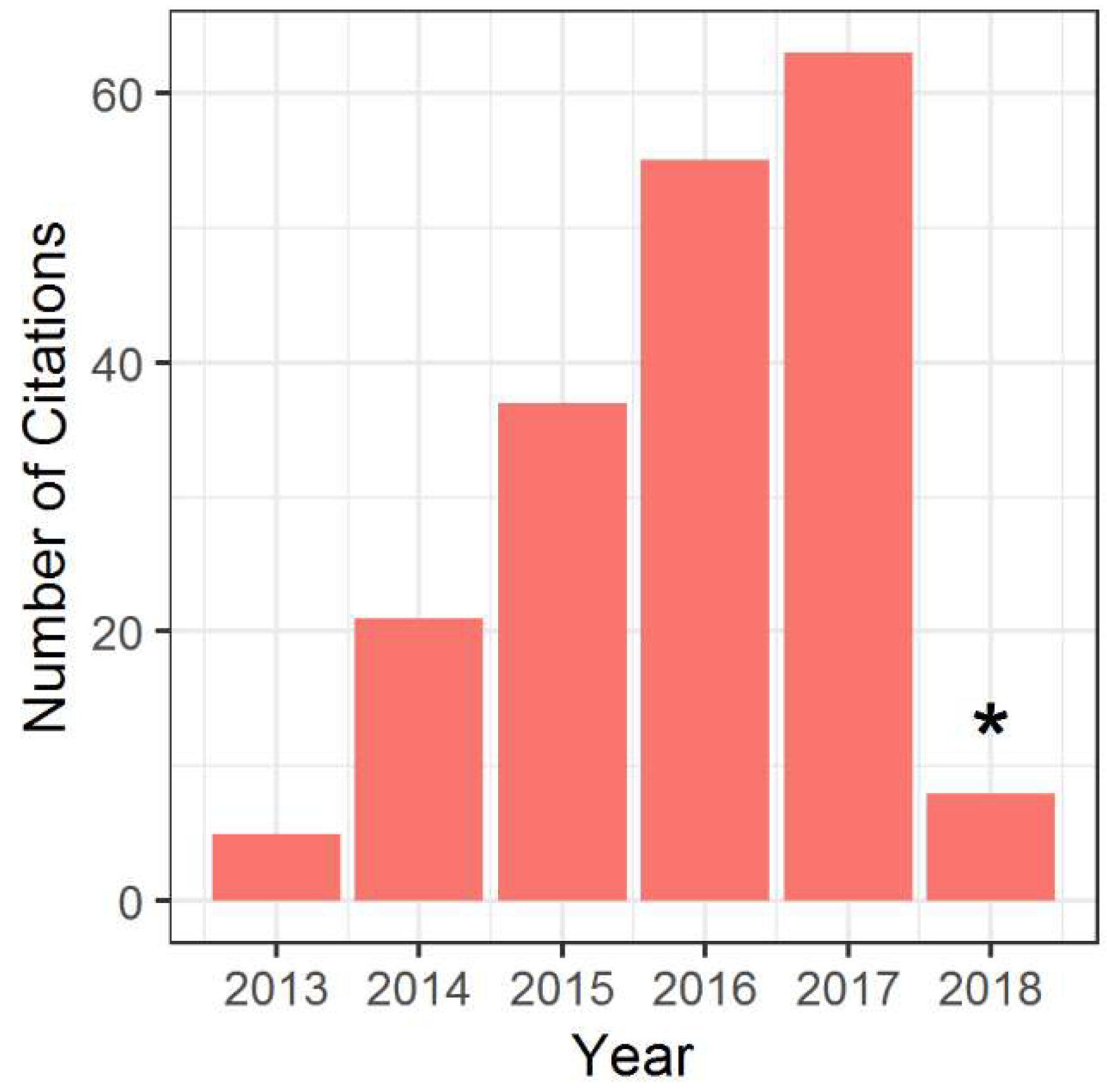
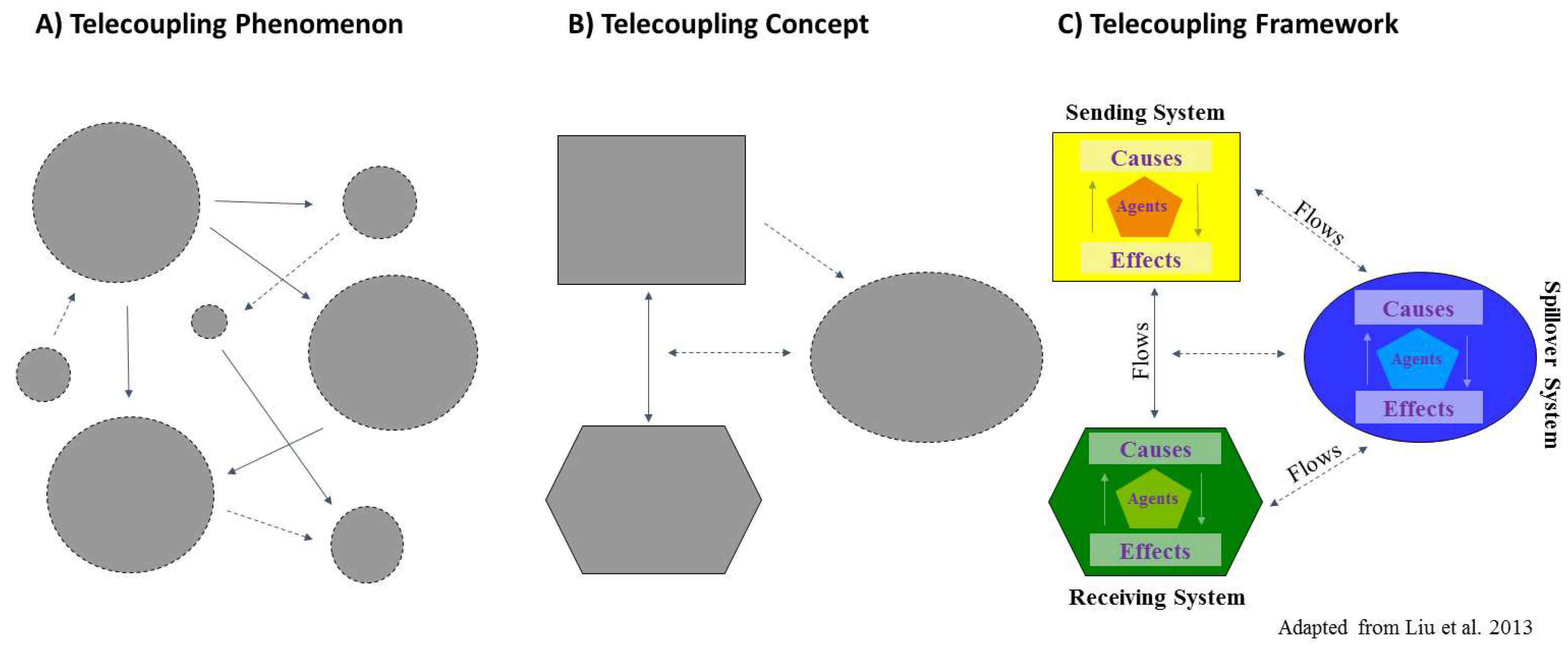
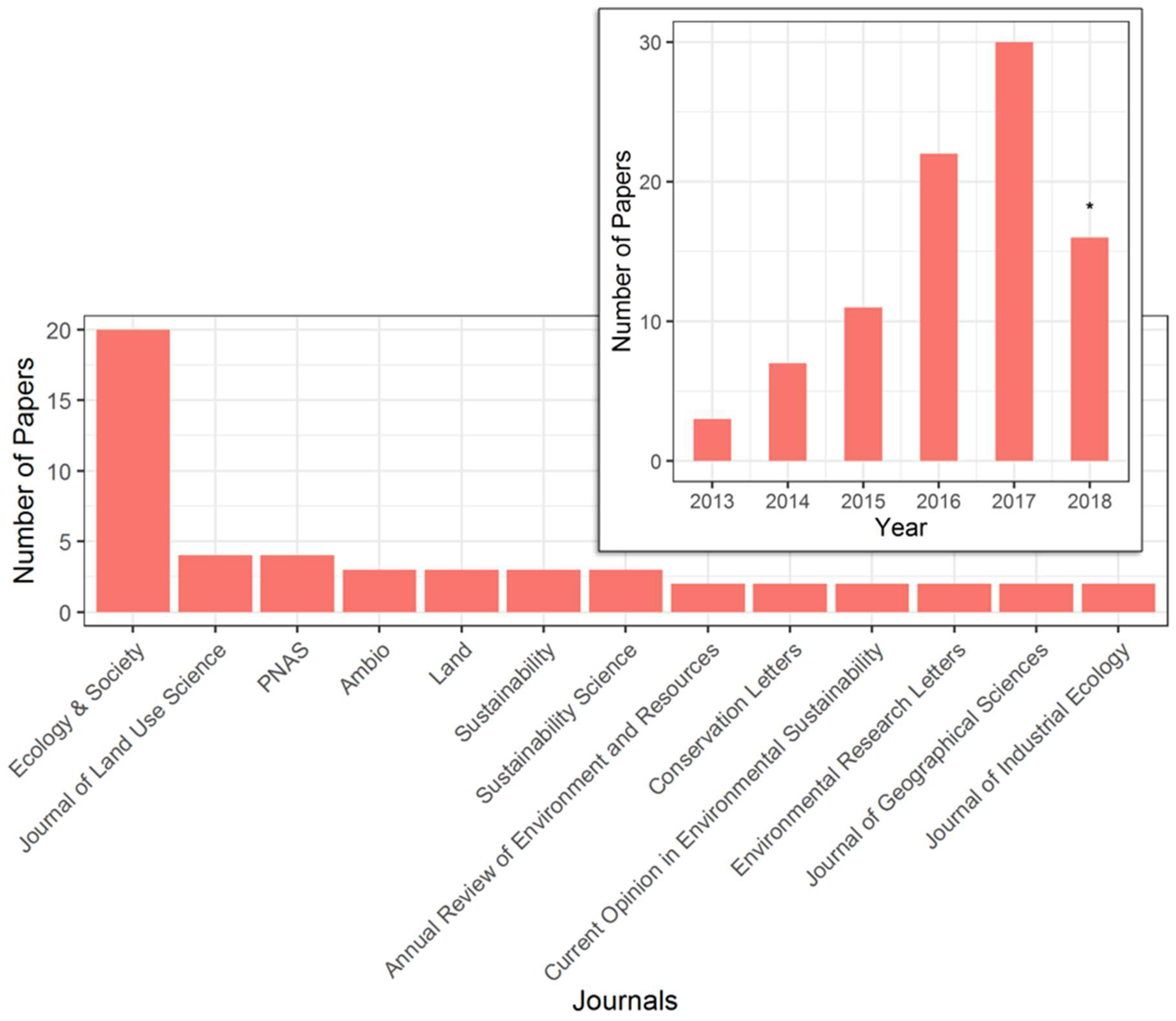
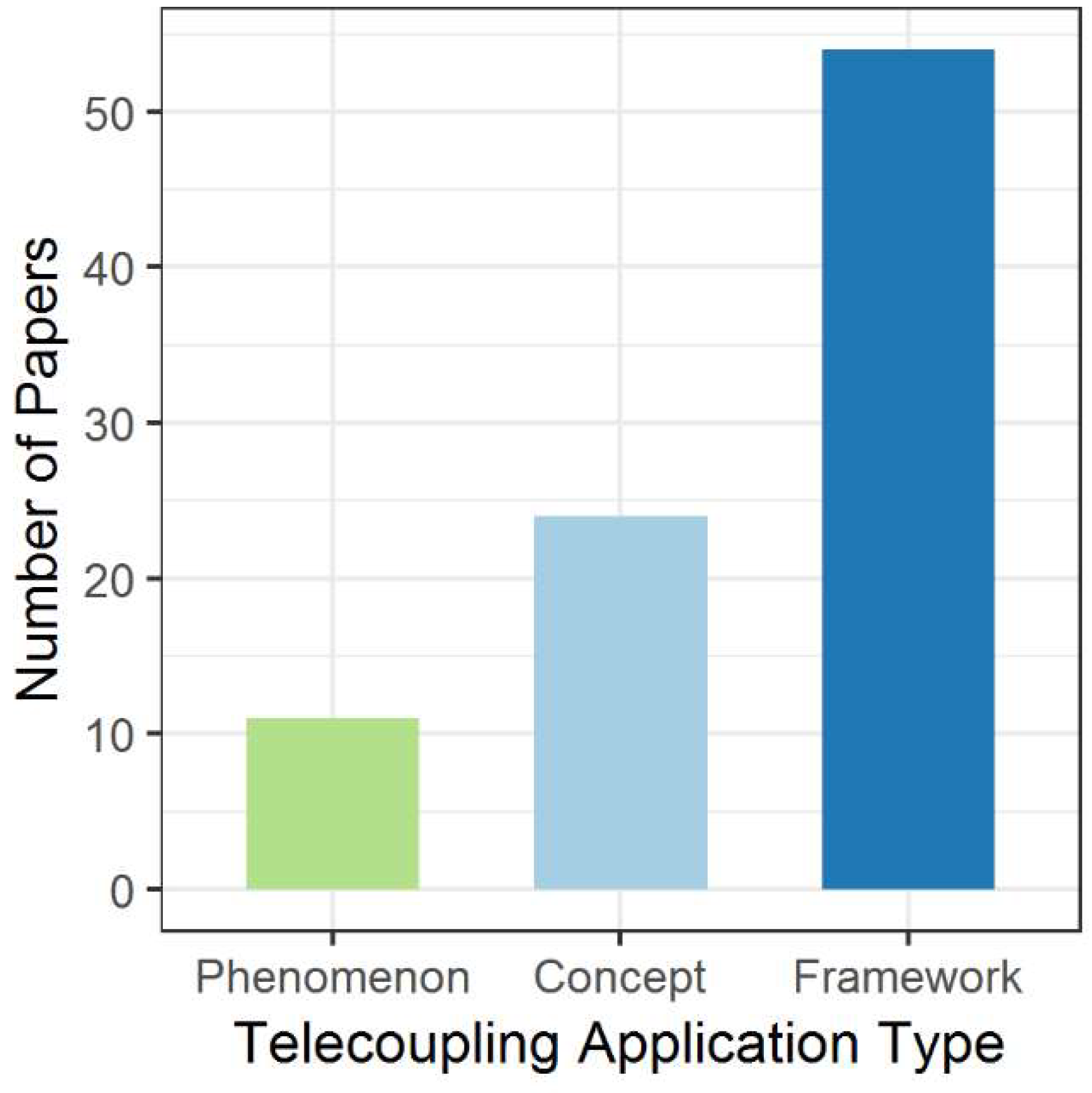
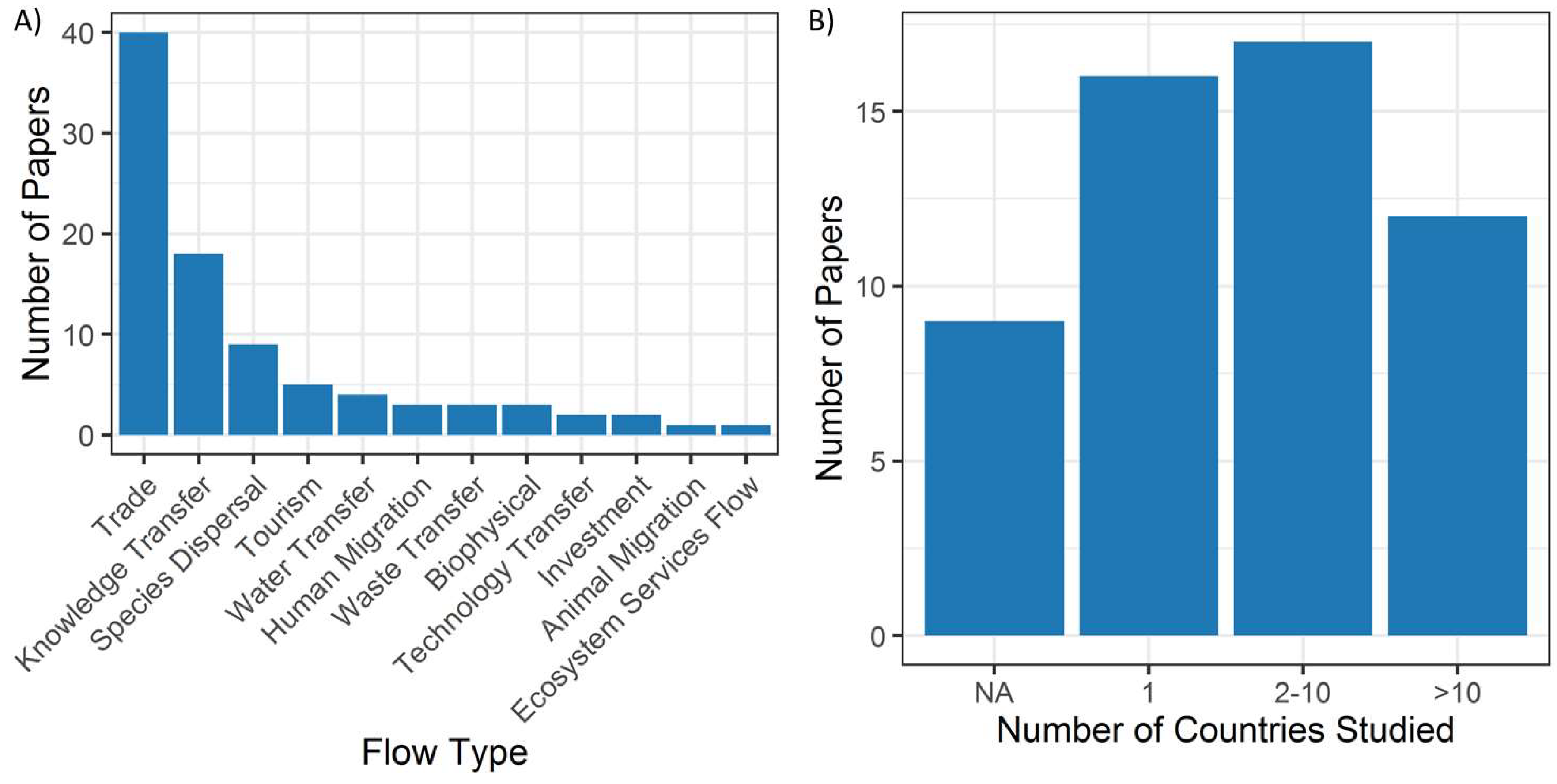
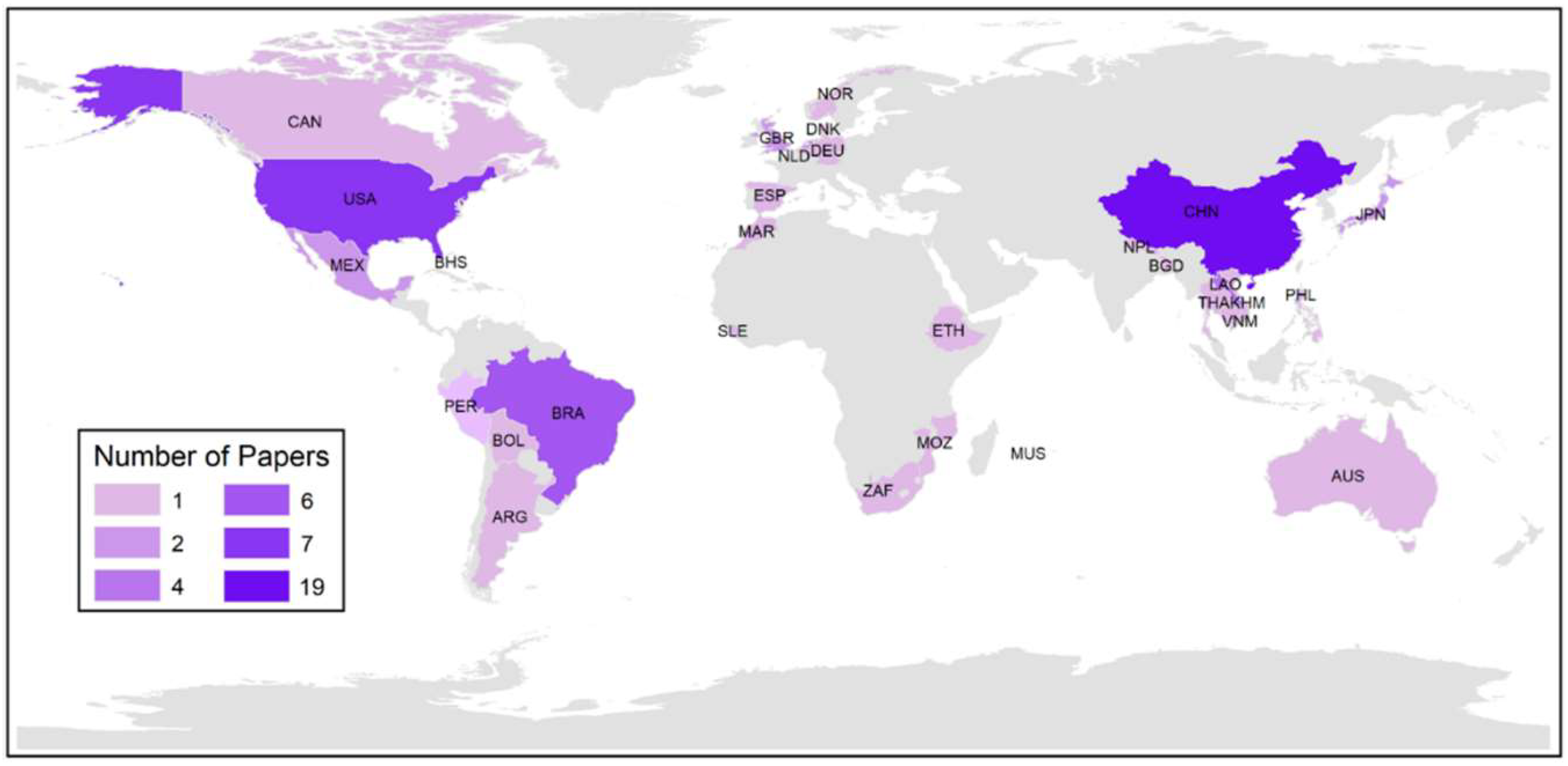
© 2019 by the authors. Licensee MDPI, Basel, Switzerland. This article is an open access article distributed under the terms and conditions of the Creative Commons Attribution (CC BY) license (http://creativecommons.org/licenses/by/4.0/).
Share and Cite
Kapsar, K.E.; Hovis, C.L.; Bicudo da Silva, R.F.; Buchholtz, E.K.; Carlson, A.K.; Dou, Y.; Du, Y.; Furumo, P.R.; Li, Y.; Torres, A.; et al. Telecoupling Research: The First Five Years. Sustainability 2019, 11, 1033. https://doi.org/10.3390/su11041033
Kapsar KE, Hovis CL, Bicudo da Silva RF, Buchholtz EK, Carlson AK, Dou Y, Du Y, Furumo PR, Li Y, Torres A, et al. Telecoupling Research: The First Five Years. Sustainability. 2019; 11(4):1033. https://doi.org/10.3390/su11041033
Chicago/Turabian StyleKapsar, Kelly E., Ciara L. Hovis, Ramon Felipe Bicudo da Silva, Erin K. Buchholtz, Andrew K. Carlson, Yue Dou, Yueyue Du, Paul R. Furumo, Yingjie Li, Aurora Torres, and et al. 2019. "Telecoupling Research: The First Five Years" Sustainability 11, no. 4: 1033. https://doi.org/10.3390/su11041033
APA StyleKapsar, K. E., Hovis, C. L., Bicudo da Silva, R. F., Buchholtz, E. K., Carlson, A. K., Dou, Y., Du, Y., Furumo, P. R., Li, Y., Torres, A., Yang, D., Wan, H. Y., Zaehringer, J. G., & Liu, J. (2019). Telecoupling Research: The First Five Years. Sustainability, 11(4), 1033. https://doi.org/10.3390/su11041033









